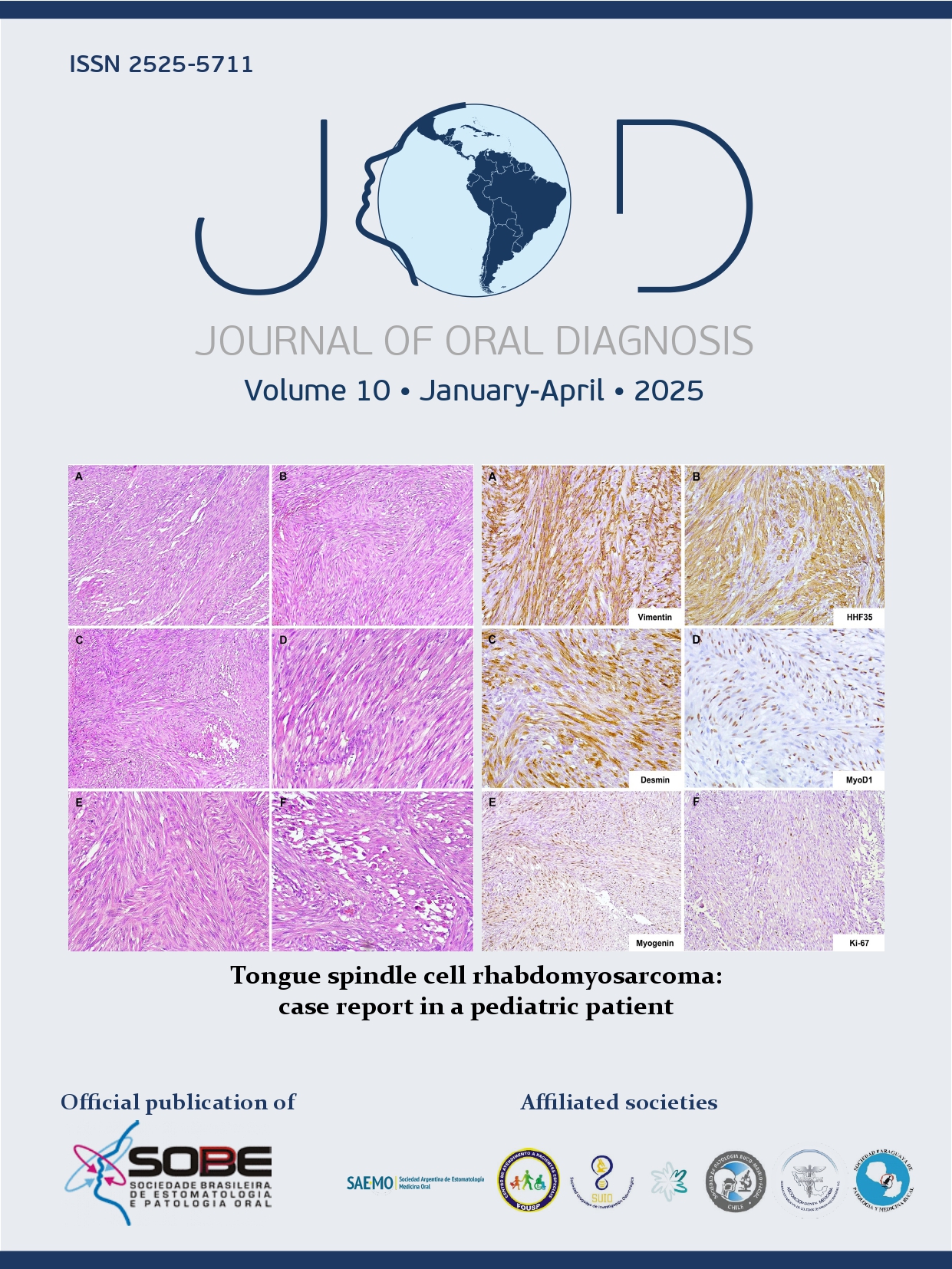Detection of oral mucosal lesions by screening examinations
DOI:
https://doi.org/10.5935/2525-5711.20200008Keywords:
Prevalence, Epidemiology, Oral Lesions, PreventionAbstract
Introduction: Studies on the prevalence of oral lesions are important to characterize their occurrence in a population. The understanding of epidemiologic aspects, etiology, natural history and risk factors related to oral pathological conditions are essential to primary prevention, early diagnosis and treatment. Objective: The aim of this study was to evaluate the prevalence of oral mucosal lesions (OML) detected during a prevention campaign in stomatology, considering clinical, demographic and social data. Materials and methods: The study was conducted with data collected from a prevention campaign in stomatology, in the state of Rio de Janeiro, Brazil. The individuals who agreed to participate in the campaign were clinically examined and answered a questionnaire with sociodemographic questions. The clinically detected OML were recorded for analysis. Results: In the three days of the campaign, 10144 individuals were evaluated. The age ranged from 0 to 96 years old, with a mean of 45.0 ± 18.4 years. Twenty two percent of the participants presented OML which required control or treatment. The most prevalent oral lesion was candidiasis (5.2 %), followed by reactive lesions (3.8%), developmental alterations (2.8%), aphthous ulceration (2.1%), conditions related to prosthesis (1.6%), leukoplakia (1.5%) and traumatic ulcers (1.4%). The prevalence of OML was higher among elderly individuals, and there were no differences between genders. Conclusion: Oral mucosa screenings are important to detect OML and to refer individuals for treatment. When oral exams are performed as part of a prevention campaign, they provide important epidemiological data.
References
Triantos D. Intra-oral findings and general health conditions among institutionalized and non-institutionalized elderly in Greece. J Oral Pathol Med. 2005 Nov;34(10):577-82.
Ferreira RC, Magalhães CS, Moreira AN. Oral mucosal alterations among the institutionalized elderly in Brazil. Braz Oral Res. 2010 Jul/Sep;24(3):296-302.
Vieira-Andrade RG, Guimarães FFZ, Vieira CS, Freire STC, Ramos-Jorge ML, Fernandes AM. Oral mucosa alterations in a socioeconomically deprived region: prevalence and associated factors. Braz Oral Res. 2011 Sep/Oct;25(5):393-400.
Do LG, Spencer AJ, Dost F, Farah CS. Oral mucosal lesions: findings from the Australian National Survey of Adult Oral Health. Aust Dent J. 2014 Mar;59(1):114-20.
Ghanaei FM, Joukar F, Rabiei M, Dadashzadeh A, Valeshabad AK. Prevalence of oral mucosal lesions in an adult Iranian population. Iran Red Crescent Med J. 2013;15(7):600-4.
Feng J, Zhou Z, Shen X, Wang Y, Shi L, Wang Y, et al. Prevalence and distribution of oral mucosal lesions: a cross-sectional study in Shanghai, China. J Oral Pathol Med. 2015 Aug;44(7):490-4.
Robledo-Sierra J, Mattsson U, Svedensten T, Jontell M. The morbidity of oral mucosal lesions in an adult Swedish population. Med Oral Patol Oral Cir Bucal. 2013 Sep;18(5):e766-72.
Jahanbani A, Morse DE, Alinejad H. Prevalence of oral lesions and normal variants of the oral mucosa in 12 to 15-year-old students in Tehran. Iran. Arch Iran Med. 2012 Mar;15(3):142-5.
Mozafari PM, Dalirsani Z, Delavarian Z, Amirchaghmaghi M, Shakeri MT, Esfandyari A, et al. Prevalence of oral mucosal lesions in institutionalized elderly people in Mashhad, Northeast Iran. Gerodontology. 2012 Jun;29(2):e930-4.
O'Sullivan EM. Prevalence of oral mucosal abnormalities in addiction treatment centre residents in Southern Ireland. Oral Oncol. 2011 May;47(5):395-9.
Tarquinio SBC, Oliveira LJC, Correa MB, Peres MA, Peres KG, Gigante DP, et al. Factors associated with prevalence of oral lesions and oral self-examination in young adults from a birth cohort in Southern Brazil. Cad Saúde Pública. 2013 Jan;29(1):155-64.
Saintrain MVL, Holanda TG, Bezerra TMM, Almeida PC. Prevalence of soft tissue oral lesion in elderly and its relations with deleterious habits. Gerodontology. 2012 Jun;29(2):130-4.
Carrard VC, Haas A, Rados PV, Ms F, Oppermann RV, Albandar JM, et al. Prevalence and risk indicators of oral mucosal lesions in an urban population from South Brazil. Oral Dis. 2011 Mar;17(2):171-9.
Mendez M, Carrard VC, Haas AN, Lauxen IS, Barbachan JJD, Rados PV, et al. A 10-year study of specimens submitted to oral pathology laboratory analysis: lesion occurrence and demographic features. Braz Oral Res. 2012 May/Jun;26(3):235-41.
Crivelli MR, Aguas S, Adler I, Quarracino C, Bazarque P. Influence of the socioeconomic status on oral mucosa lesion prevalence in schoolchildren. Community Dent Oral Epidemiol. 1988 Feb;16(1):58-60.
Epstein JB, Villines D, Drahos G, Kaufman E, Gorsky M. oral lesions in patients participating in an oral examination screening week at an urban dental school. J Am Dent Assoc. 2008;139(10):1338-44.
Byakodi R, Shipurkar A, Byakodi S, Marathe K. Prevalence of oral soft tissue lesions in Sangli, India. J Community Health. 2011 Oct;36(5):756-9.
Abdullah MJ. Prevalence of recurrent aphthous ulceration experience in patients attending piramird dental speciality in Sulaimani City. J Clin Exp Dent. 2013;5(2):e89-94.
Liang MW, Neoh CY. Oral aphthosis: management gaps and recent advances. Ann Acad Med Singapore. 2012 Oct;41(10):463-70.
Preeti L, Rajkumar K, Karthik R. Recurrent aphthous stomatitis. J Oral Maxillofac Pathol. 2011 Sep;15(3):252-6.
Subramanyam RV. Occurrence of recurrent aphthous stomatitis only on lining mucosa and its relationship to smoking - a possible hypothesis. Med Hypotheses. 2011 Aug;77(2):185-7.
Darwazeh AM, Al-Dwairi ZN. The relationship between tobacco smoking and oral colonization with candida species. J Contemp Dent Pract. 2010 May;11(3):17-24.
Pahwa V, Nair S, Shetty RS, Kamath A. Prevalence of oral premalignant lesions and its risk factors among the adult population in Udupi Taluk of Coastal Karnataka, India. Asian Pac J Cancer Prev. 2018;19(8):2165-70.
Birur NP, Patrick S, Bajaj S, Raghavan S, Suresh A, Sunny SP, et al. A novel mobile health approach to early diagnosis of oral cancer. J Contemp Dent Pract. 2018 Sep;19(9):1122-9.
Downloads
Published
How to Cite
Issue
Section
License
Copyright (c) 1969 Sandra R Torres, Natalia Tavares Souza, Mário JoséRomañach Romañach, Marilia Heffer Cantisano, Ronir Raggio Luiz, Abel Silveira Cardoso

This work is licensed under a Creative Commons Attribution 4.0 International License.










